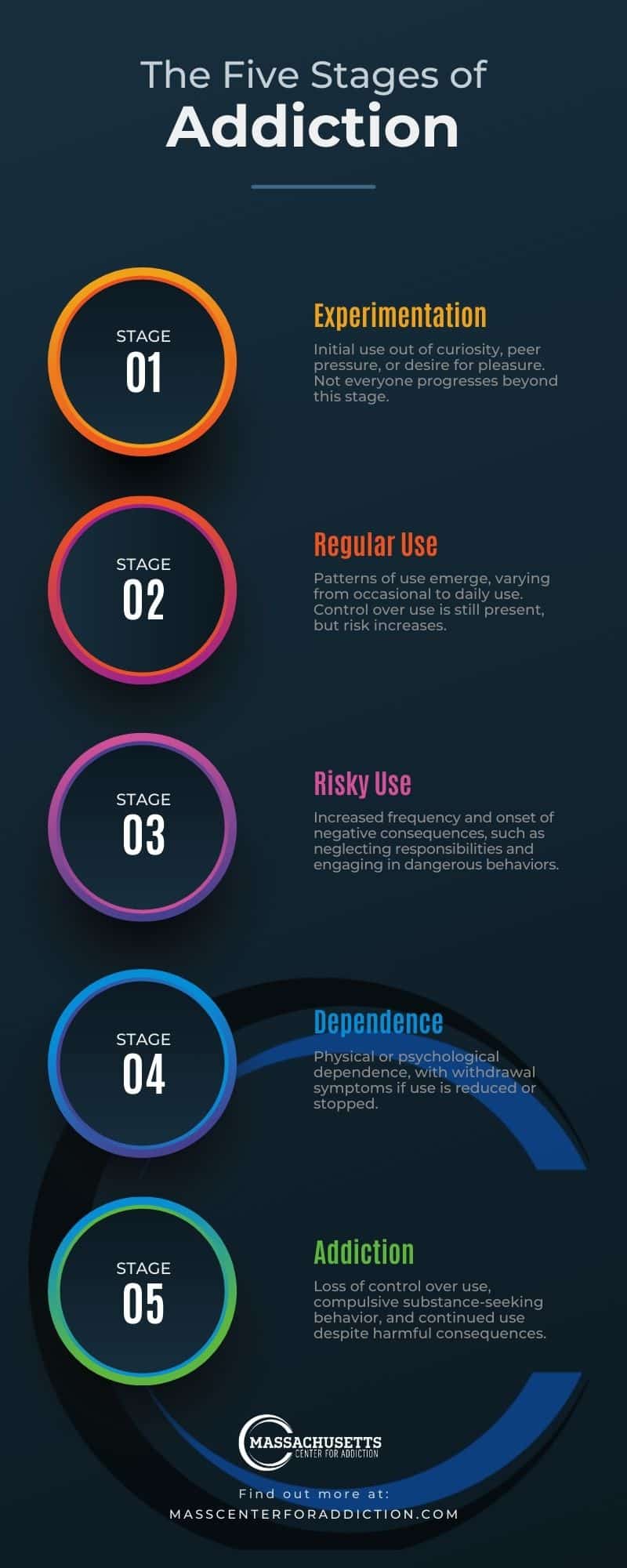Massachusetts Center for Addiction
Stages of Addiction

If you have ever wondered about the different stages of addiction, you are not alone. Addiction is a complicated illness that affects important parts of the brain. It is characterized by an uncontrollable urge to use substances or engage in activities despite negative consequences. To understand addiction completely, it’s important to discuss the various stages and what occurs during each stage.
What are the Stages of Addiction?
Recognizing the stages of addiction provides a roadmap for understanding this often misunderstood disorder. Substance use disorders (SUDs) develop gradually and can be categorized into several distinct stages.
Each stage signifies a different level of involvement with the substance, from initial use to full-blown addiction. Understanding these stages is critical as it offers insights into the addiction cycle and facilitates early intervention.
It’s important to remember that the progression through these stages can vary greatly from person to person. Some people may progress rapidly through the stages, while others may remain at one stage for an extended period of time.

Explaining the Different Stages of Addiction
Understanding the stages of addiction involves recognizing the gradual process that can lead to a full-blown substance use disorder. Each stage represents different levels of involvement with the substance. The effects on the individual’s life become more severe and pervasive as they progress through the stages.
Stage 1: Experimentation
The first stage of addiction, experimentation, is where an individual first tries a substance. This stage is usually motivated by curiosity, peer pressure, or a desire for pleasure. The effects of addictive substances on the brain’s reward system, particularly the release of dopamine, can make this initial experience pleasurable and memorable.
However, not everyone who experiments with substances will progress to the next stage of addiction. Factors such as genetics, environment, and the individual’s mental health can influence the risk of progression.
Stage 2: Regular Use
As an individual continues to use a substance, they may enter the stage of regular use. Here, patterns of substance use begin to emerge, which can vary significantly among individuals. For instance, some might only use substances in certain situations or at specific times, like on weekends, while others might start using substances daily.
Even though the person may still have control over their use, the potential for developing a substance use disorder increases.
Stage 3: Risky Use
The stage of risky use is characterized by an increased frequency of substance use and the onset of negative consequences. The individual might start neglecting responsibilities or experience problems in relationships due to their substance use.
They may also engage in risky behaviors, such as driving under the influence or using substances in unsafe conditions. The risky use stage is where the negative effects of substance use become increasingly apparent, signaling a growing problem.
Stage 4: Dependence
Dependence is the stage where the individual becomes physically or psychologically dependent on the substance. Substance dependence is characterized by the experience of withdrawal symptoms when the substance use is reduced or stopped.
These symptoms can range from mild, such as anxiety and irritability, to severe, including seizures and hallucinations. Dependence indicates that the individual’s brain has adapted to the regular presence of the substance, and changes in neurotransmitter systems have occurred.
Stage 5: Addiction
The final stage, addiction, is the most severe stage of a substance use disorder. It is characterized by a loss of control over substance use and continued use despite experiencing harmful consequences. Individuals at this stage may have made repeated attempts to quit using the substance but have been unsuccessful due to intense cravings and withdrawal symptoms.
Substance-seeking behavior becomes compulsive, and obtaining and using the substance becomes the primary focus of the individual’s life, often at the expense of health, relationships, and responsibilities.
Why Understanding the Stages of Addiction is Important
Understanding the stages of addiction is important for several reasons.
Firstly, it can help individuals and their family members recognize the signs of addiction, allowing for early intervention.
Secondly, it provides a framework for understanding the process of addiction. This can be helpful for those affected by substance use disorders and their loved ones.
Thirdly, knowledge of these stages can inform treatment strategies and improve the effectiveness of interventions.
Understanding the stages of addiction is a crucial aspect of the recovery journey. It offers valuable insights into the intricate nature of substance use disorders and the cyclical pattern of addiction. This knowledge can be instrumental in early detection, intervention, and effective addiction treatment planning.
Get The Help You Need
At the Massachusetts Center for Addiction, we are committed to guiding individuals with a team of dedicated professionals ready to provide the necessary support and treatment. We believe in the power of knowledge, and understanding the stages of addiction is a pivotal step toward recovery.
Don’t hesitate to reach out if you or a loved one is struggling with substance use. Recovery is not just a possibility but a reality for many who have walked this path before. Our team at the Massachusetts Center for Addiction is here to help you navigate this process. Contact us today to learn more about our programs and begin your journey toward a healthier life.



